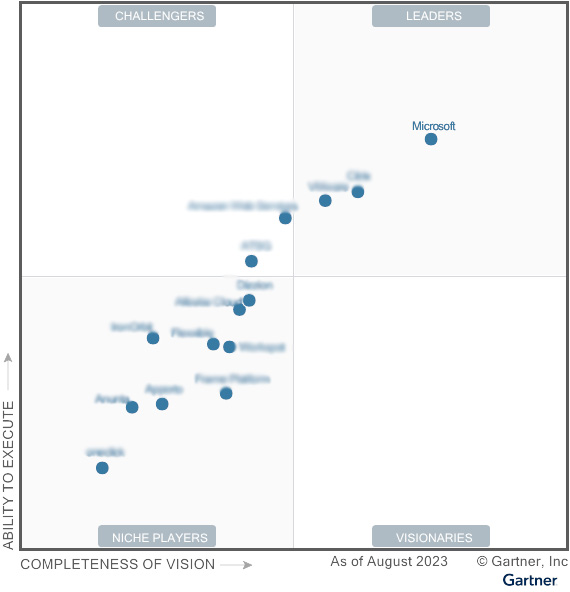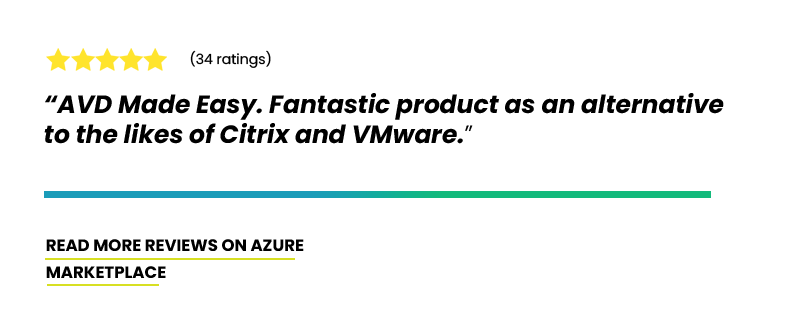Gartner data indicates the DaaS (desktop-as-a-service) market will grow from $3.1 billion in 2023 to $4.6 billion in 2027 as businesses continue to move away from traditional virtual desktop infrastructure (VDI) services to better accommodate the modern workforce. While Citrix has long been a dominant player in the IT space, new competitors are challenging its position with innovative cloud-first approaches and cost-effective solutions.
In this post, we’ll examine different virtual desktop solutions side-by-side, looking at Citrix’s role as the legacy vendor, challenger brands, and the pros and cons of each. We’ll also explore the unique advantages of pairing Microsoft AVD with Nerdio and why this combination is gaining traction as the preferred choice for modern IT infrastructure needs.

The problem: Why organizations are seeking alternatives to Citrix
Citrix has been a stalwart solution for virtual desktop infrastructure, but its drawbacks are becoming increasingly evident as organizations seek more efficient and cost-effective alternatives.
Pros of Citrix:
- Comprehensive feature set: Citrix boasts a comprehensive suite of features for virtual desktop infrastructure, including application delivery management, unified endpoint management, and security capabilities.
- Legacy support: As a legacy vendor in the VDI industry, Citrix has a large and established customer base, along with a wealth of documentation, training resources, and third-party integrations.
Cons of Citrix:
- Complexity and management overhead: Setting up and configuring Citrix environments often requires specialized expertise and extensive hands-on management, generating increased administrative burden and operational costs.
- High total cost of ownership (TCO): Citrix deployments can be prohibitively expensive, with high upfront costs for licensing fees and additional infrastructure investments. Moreover, ongoing maintenance and support expenses can further inflate the TCO for Citrix solutions, making them even less cost-effective in the long run.
- Vendor lock-in: Organizations that rely heavily on Citrix technologies may find themselves locked into a vendor-specific ecosystem, making it challenging to switch to alternative solutions in the future. This can limit flexibility and innovation, hindering the organization’s ability to adapt to changing business needs.
Assessing Amazon Web Services
Amazon Web Services (AWS) offers a range of DaaS solutions, including Amazon WorkSpaces, Amazon WorkSpaces Core, Amazon WorkSpaces Web, and Amazon AppStream 2.0. The vendor also provides global coverage, catering to the needs of organizations looking to enable secure, low-latency access for overseas contact centers or business process outsourcing.
Pros of Amazon Web Services:
- Greater flexibility: AWS DaaS solutions are highly scalable and flexible, allowing organizations to quickly provision and scale virtual desktops based on changing demand.
- Integration with AWS ecosystem: AWS DaaS solutions seamlessly integrate with the broader AWS ecosystem, enabling businesses to leverage existing AWS services and tools for enhanced functionality and interoperability.
- Pay-as-you-go pricing model: AWS follows a pay-as-you-go pricing model for its DaaS solutions, allowing organizations to pay only for the resources used.
Cons of Amazon Web Services:
- Complex offering: Setting up and configuring AWS DaaS solutions can be complicated, especially for organizations with limited cloud expertise. Deploying remote desktops, configuring networking, and managing user access requires specialized knowledge and skills, leading to increased deployment times and potential errors.
- Management overhead: AWS DaaS solutions entail a significant management overhead. Managing user identities, implementing security policies, and monitoring desktop performance can be time-consuming and resource-intensive, requiring dedicated IT resources for administration and maintenance.
- Lifecycle management challenges: Amazon WorkSpaces predominantly rely on Windows Server 2019, which is set to reach the end of mainstream support by January 2024. Although server support extends beyond this date, certain critical applications like Microsoft Office and Microsoft 365 will no longer be maintained once mainstream support ends.
- Real-time audio and video enhancements: While Amazon WorkSpaces offers native optimization for WebRTC and Zoom traffic at the endpoint level, they currently lack optimization features for Microsoft Teams. Therefore, all voice and video processing occurs in the cloud, increasing resource demands and potentially prompting clients to opt for higher-specification virtual machines.
Evaluating VMware Horizon
VMware Horizon is a globally adopted DaaS solution serving clients across all industry sectors and enterprise scales, with a notable presence in larger enterprises with stringent regulatory compliance needs.
Pros of VMware Horizon:
- Advanced API architecture: VMware Horizon has a well-built API framework, facilitating seamless integration with analytics, automation, and other essential systems. Customers benefit from low-code automation platforms, which help them to tailor automation to their unique business workflows.
- Hybrid and multi-cloud capabilities: VMware offers support for various cloud configurations, spanning popular public cloud vendors and enabling on-premises deployments.
- Integration with the VMware ecosystem: VMware Horizon integrates with other VMware products and solutions, such as vSphere and vCenter, providing businesses with a unified platform for managing their virtual infrastructure.
Cons of VMware Horizon:
- Complexity of deployment: Setting up and deploying VMware Horizon can be very challenging. Once again, configuring virtual desktops, networking, and user access often requires knowledge specific to VMware technology.
- Resource intensive: Running VMware Horizon is resource-intensive, requiring dedicated hardware and infrastructure to support virtual desktop instances. Organizations will likely need to invest in additional compute, storage, and networking resources to ensure optimal performance and reliability, adding to the overall deployment costs.
- Cost of licensing and support: VMware Horizon entails significant upfront costs for licensing and support, particularly for companies with large-scale deployments or complex use cases.
Analyzing ATSG
ATSG (Advanced Technology Services Group) is a prominent player in the DaaS market, offering a robust Cloud PC solution encompassing both desktop and application virtualization options. Its clientele spans various industry verticals, concentrating largely in healthcare, hospitality, and education sectors.
Pros of ATSG:
- Tailored solutions: ATSG offers tailored DaaS solutions that cater to the specific needs and requirements of organizations across various industries. Whether it’s supporting remote workforces, enabling BYOD (bring your own device) initiatives, or enhancing data security, ATSG addresses each customer’s unique business challenges.
- Managed services: ATSG provides managed DaaS services, allowing organizations to offload the management and maintenance of their virtual desktop infrastructure to experienced professionals.
- Security and compliance: ATSG prioritizes security and compliance in its DaaS offerings, implementing solid security measures and adhering to industry regulations and standards.
Cons of ATSG:
- Limited brand recognition: Compared to established players, ATSG has limited brand recognition in the DaaS market. This can potentially impact organizations’ confidence in ATSG’s capabilities and hinder adoption among decision-makers.
- Cost considerations: While ATSG offers tailored DaaS solutions, organizations must carefully evaluate the cost implications of partnering with ATSG. Depending on the scope of services and level of customization required, ATSG’s DaaS offerings can entail significant upfront costs and ongoing expenses, which affects the overall return on investment.
- Dependency on the service provider: Organizations that rely on ATSG for managed DaaS services often face dependency on the service provider for ongoing support and maintenance. This dependency poses challenges in terms of service availability, responsiveness, and alignment with organizational objectives.
- Integration challenges: Integrating ATSG’s DaaS solutions with existing IT infrastructure and applications may present challenges for organizations, particularly if compatibility issues arise or if customizations are required. Seamless integration is essential to ensure a smooth transition and minimize disruption to business operations.
Microsoft Azure Virtual Desktop: the top contender
Microsoft Azure Virtual Desktop (AVD) stands out as a leading enterprise VDI solution, offering unparalleled scalability, security, and flexibility for organizations of all sizes. When paired with Nerdio, Microsoft AVD provides a competitive advantage that empowers businesses to modernize their IT infrastructure and enhance user productivity.
Pros of Microsoft AVD:
- Scalability and flexibility: AVD enables organizations to quickly scale their virtual desktop infrastructure up or down based on fluctuating needs. Whether it’s adding new users or virtual machines, deploying additional applications, or expanding to new locations, AVD offers the agility and flexibility needed to support organizational growth and evolution.
- Security and compliance: Microsoft Azure is renowned for its robust security features and compliance certifications, and AVD inherits these capabilities to provide a secure virtual desktop environment. From data encryption and access controls to threat detection and identity management, Microsoft AVD helps organizations mitigate security risks and ensure compliance with industry regulations and standards.
- The Microsoft ecosystem and partnerships: As part of the Microsoft ecosystem, AVD seamlessly integrates with other Microsoft services and applications, including Microsoft 365, Teams, and Entra ID (formerly Azure Active Directory). This integration simplifies deployment, management, and user authentication, enhancing overall productivity and collaboration within the organization. Further, customers receive access to the largest partner ecosystem in the industry, offering a wide range of additional services.
- Cost-effective pricing model: Microsoft AVD offers a consumption-based pricing model, allowing organizations to pay only for the resources they use. This cost-effective pricing model eliminates the need for upfront hardware investments and allows organizations to optimize their IT spending based on actual usage and demand.
- Enhanced user experience: With Microsoft AVD, users can access their virtual Windows desktops and applications anywhere and from any device, providing a consistent and seamless user experience. Whether it’s working from home, on the go, or in the office, AVD ensures that users have access to their desktop environment and tools whenever they need them.
Cons of Microsoft AVD:
- Learning curve: Implementing and managing AVD may require some training and familiarization with the Azure platform and associated tools, particularly for IT administrators who are new to cloud-based virtual desktop environments.
- Complexity of configuration: While AVD offers extensive customization options, configuring and optimizing the environment for specific organizational requirements requires careful planning and expertise.
Nerdio eliminates the cons of AVD
Nerdio serves as the ideal complement to Microsoft AVD by specifically addressing the challenges encountered with AVD implementation and management. Nerdio significantly reduces the learning curve associated with AVD by offering intuitive management interfaces and step-by-step guidance tailored for IT administrators.
Moreover, the platform simplifies the complexity of AVD configuration by providing pre-configured templates and automation workflows that streamline the setup process and ensure optimal performance.
By leveraging Nerdio’s advanced management and automation capabilities, organizations can effortlessly deploy, manage, and optimize their AVD environments with minimal expertise required, ultimately enhancing operational efficiency and reducing administrative overhead.
